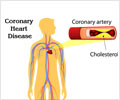According to a recent study conducted in animals, unrestricted somatic stem cells derived from umbilical cord blood are better in repairing heart attack damage compared to mesenchymal stem cells derived from bone marrow.
Stem cells, found in embryonic tissue, extraembryonic tissue and even in adult organs, are being widely studied by tissue engineering scientists for their use in tissue repair of various organs including the heart, brain and pancreas. But the function and differentiation potential (capability of developing into specialized cells) vary according to the different stem cell types.Earlier studies have found that bone-marrow derived mesenchymal stem cells (MSC) limit the extent of damage in acute myocardial infaction (heart attack) by accelerating the normal healing process, limiting scar formation, inhibiting cell death (necrosis) and potentially regenerating cardiac muscle. Again, greater improvement in cardiac function was found when anti-cell death gene Akt was introduced into bone marrow MSC and delivered via intra-coronary route.
Similarly, another type of stem cell called unrestricted somatic stem cell (USSC), which is derived from umbilical cord blood and capable of forming any type of cell including nerve, bone, heart, liver or blood cells, has been found to have a wider differentiation potential and thus have a greater capacity for cardiac repair. Studies have also indicated USSC to have immunosuppressive properties that protect from immune rejection, giving it an advantage over MSC.
So, Aidan Flynn and colleagues, from the National Centre for Biomedical Engineering Science, National University of Ireland, performed a comparison of the effectiveness of the USSC and bone marrow derived MSC on animal models and also aimed to determine if exposing the USSC cells to guiding factors before cell transplantation could enhance their therapeutic efficacy. Guiding factors were used to make the cells more cardiac specific.
In the study, female experimental animals were divided into 5 groups which were assigned to receive (respective cells cultured in F12 medium)
• Bone marrow derived MSC, 24 hours after heart attack
• Guided USSC or cUSSC, 24 hours after heart attack (USSC were guided by exposure to guidance factors - 50ng/ml bFGF, 20ng/ml HGF and 20ng/ml BMP2 - for 24 hours.)
• Control animals with no intervention after the heart attack.
The cardiac function was measured by ejection fraction (EF), that is, ‘the percentage of blood that is pumped out of a filled ventricle as a result of a heartbeat’. In other words, EF is a measure of heart health and after a heart attack, the EF decreases.
The findings were
• Cardiac function: At 28 days post heart attack, EF did not improve in either MSC group or USSC group. Further decline in EF was prevented in USSC group but not in MSC group. Delivery of guided USSC (cUSSC) significantly improved EF and restored cardiac function to a greater extent than MSC.
• Area of cell death in heart following a heart attack (infarct area): There was no difference in infarct area following administration of either MSC or USSC or cUSSC.
• Apoptosis and angiogenesis: Apoptosis is the process of orchestrated cell death resulting because of biochemical events. Angiogenesis is the formation of new blood vessels, especially those that supply oxygen to the diseased tissue. This study revealed that neither apoptosis nor angiogenesis differed between groups.
The researchers concluded that ‘guided USSC has a moderate capacity to repair cardiac damage and they are more effective than MSC in restoring cardiac function following a myocardial infarction’.
Reference: Flynn AW, Chen X, O'Connell E, O'Brien T. A comparison of the efficacy of transplantation of bone marrow derived mesenchymal stem cells and unrestricted somatic stem cells on outcome after acute myocardial infarction. Stem Cell Res Ther. 2012 Sep 13;3(5):36.
Source-Medindia















